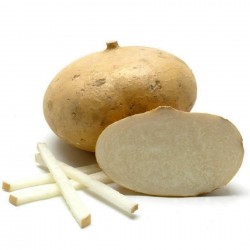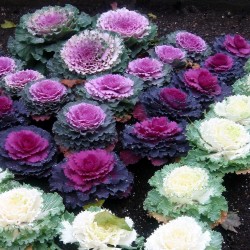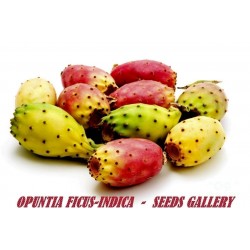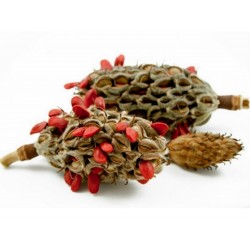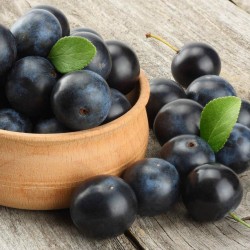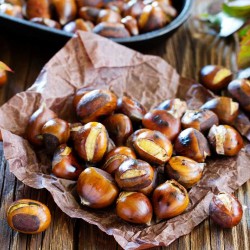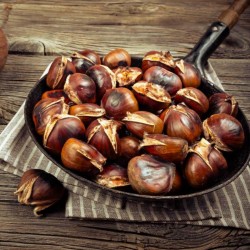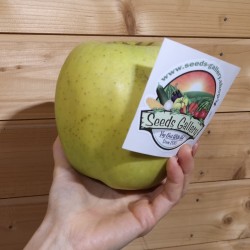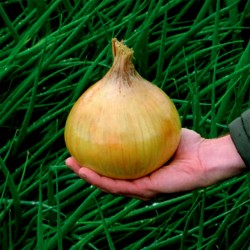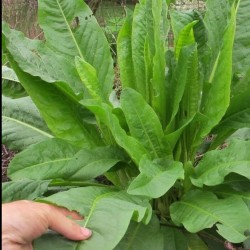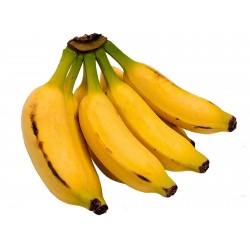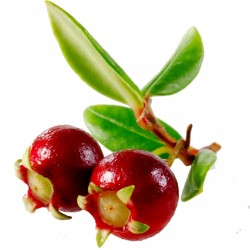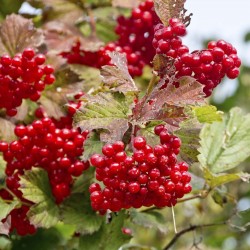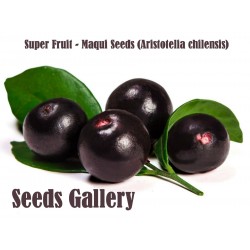
Plant bestand tegen kou en vorst
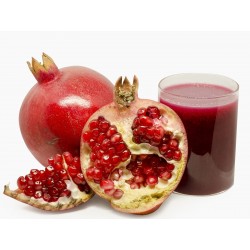
Granaatappel Zaden (Punica...
Prijs
€ 2,45
(SKU: V 117 O)
Seeds Gallery EU,
5/
5
<h2><strong>Granaatappel Zaden (Punica granatum)</strong></h2>
<h2><span style="color: #ff0000;" class=""><strong>Prijs per verpakking van 50 zaden.</strong></span></h2>
<p>De<span> </span><b>granaatappel</b><span> </span>(<i>Punica granatum</i>) is zowel de één tot zes meter hoge<span> </span>struik<span> </span>met lange, doornige takken, als de<span> </span>vrucht<span> </span>van deze struik. De plant behoort tot de<span> </span>kattenstaartfamilie<span> </span>(<i>Lythraceae</i>) dan wel de familie<span> </span><i>Punicaceae</i><span> </span>(orde is in revisie).</p>
<p>De struik kan in<span> </span>droge tijden, zoals in de winter, zijn<span> </span>bladeren<span> </span>verliezen. De kortgesteelde, glanzende, groene tegenoverstaande bladen groeien dicht op elkaar. De bladen zijn ovaal en toegespitst met een gave rand. Ze zijn 0,5-2,5 x 1-10 cm groot.</p>
<p>De oranjerode<span> </span>bloemen<span> </span>vormen zich aan de toppen van de scheut of aan korte zijscheuten in groepen van een tot vijf. Granaatappel is zelfbestuivend. In warme zomers kan de struik<span> </span>vrucht<span> </span>te gaan dragen. De vrucht van de granaatappel is rond en 8 à 12 cm groot. De vrucht is heel sappig en bevat grote cellen zoals een<span> </span>citrusvrucht, maar in elke cel zit een pitje van ongeveer 3 mm groot. Om de pitjes zit een soort gelei, zoals om de pitjes van een tomaat. Bovendien bevat de vrucht veel vellen. De vellen smaken niet lekker. Bij rijpe vruchten is het vruchtvlees donkerrood. De schil is erg stevig en leerachtig.</p>
<p>Op meerdere Griekse eilanden komen ondersoorten voor die redelijk vorstbestendig zijn. Deze groeien voornamelijk in de bergen, en worden in Nederland aangeboden. De winterhardheid van deze struik of boom is tot -15 graden Celsius. Oudere bomen zijn het sterkst.</p>
<h2><span class="mw-headline" id="Herkomst">Herkomst</span></h2>
<p>Granaatappels waren oorspronkelijk afkomstig uit<span> </span>Perzië (tegenwoordig: Iran)<span> </span>en worden al eeuwenlang gekweekt rond de Middellandse Zee, het<span> </span>Midden-Oosten,<span> </span>Afghanistan,<span> </span>India<span> </span>en de<span> </span>Kaukasus. De geslachtsnaam van de struik,<span> </span><i>Punica</i>, is een herinnering aan de<span> </span>Feniciërs, die de teelt hebben verspreid, deels om religieuze redenen. Het<span> </span><i>granatum</i><span> </span>komt van het<span> </span>Latijnse<span> </span>woord voor korrel,<span> </span><i>granum</i>. De edelsteen<span> </span>granaat<span> </span>is waarschijnlijk naar de granaatappel genoemd, niet alleen vanwege de kleur, maar ook vanwege de vorm van de cellen, die wel wat op edelsteentjes lijken.</p>
<h2><span class="mw-headline" id="Gebruik">Gebruik</span></h2>
<p>De vrucht van de granaatappel kan uitgeperst worden, waarbij veel vruchtvlees verloren gaat. Het sap van de granaatappel vormde oorspronkelijk de basis voor<span> </span>grenadine. Grenadine is lange tijd de algemene benaming voor allerlei<span> </span>siropen<span> </span>geweest, zoals<span> </span>limonadesiroop<span> </span>dat nu is. Het is tegenwoordig een soort limonadesiroop die wordt gebruikt in cocktails, zoals in<span> </span>tequila sunrise, en grenadine wordt niet meer gemaakt van granaatappelsap, maar is het een mengsel van andere vruchtensappen.</p>
<p>Diverse granaatappeldranken zijn in Nederland verkrijgbaar.</p>
<h2><span class="mw-headline" id="Mythologie_en_religie">Mythologie en religie</span></h2>
<p>Granaatappels staan symbool voor vruchtbaarheid vanwege hun vele zaden, maar ook voor de dood vanwege de rode kleur van het binnenste van de vrucht.</p>
<p>De Griekse godin<span> </span>Persephone<span> </span>werd gedwongen elk half jaar naar de<span> </span>Hades<span> </span>terug te keren omdat ze zes granaatappelzaden had gegeten.</p>
<p>In de Bijbel (Tenach<span> </span>of<span> </span>Oude Testament) wordt de granaatappel vaak genoemd. In het<span> </span>Hooglied<span> </span>worden bijvoorbeeld de wangen van de vrouw vergeleken met een granaatappel.</p>
<div class="thumb tleft">
<div class="thumbinner"><img alt="Granaatappel Zaden (Punica granatum)" src="https://upload.wikimedia.org/wikipedia/commons/thumb/0/0f/Porteur_offrandes_grenades.jpg/260px-Porteur_offrandes_grenades.jpg" decoding="async" width="260" height="436" class="thumbimage" srcset="//upload.wikimedia.org/wikipedia/commons/thumb/0/0f/Porteur_offrandes_grenades.jpg/390px-Porteur_offrandes_grenades.jpg 1.5x, //upload.wikimedia.org/wikipedia/commons/thumb/0/0f/Porteur_offrandes_grenades.jpg/520px-Porteur_offrandes_grenades.jpg 2x" data-file-width="871" data-file-height="1462" title="Granaatappel Zaden (Punica granatum)" />
<div class="thumbcaption">
<div class="magnify"></div>
Een offerdrager met granaatappelen, Egyptische muurschildering.</div>
</div>
</div>
<p>De eerste afbeeldingen van de granaatappelboom zijn gevonden op grafschilderingen van de Egyptenaren van 2500 voor Christus. De boom wordt al sinds de oudheid geprezen om zijn gezonde invloed en koninklijke uitstraling. Hij staat voor de vernieuwing van de natuur en is een symbolische weergave van de diversiteit en eenheid van het leven.</p>
<p>Toetanchamon<span> </span>kreeg in zijn graftombe granaatappels mee om de wedergeboorte te bevorderen.</p>
<p>De Egyptenaren dachten zelfs dat granaatappelsap een levenselixer was dat onsterfelijk maakte. In China is de granaatappel een van de drie gezegende vruchten van het<span> </span>boeddhisme. De granaatappel wordt daar gezien als een vrucht met geconcentreerde levenskracht.</p>
<p>Als teken van rijkdom en vruchtbaarheid is de granaatappel ook gebruikt in de aankleding van de eerste tempel van koning<span> </span>Salomo. Beide pilaren bij de ingang zouden zijn getooid met twee rijen van granaatappels.</p>
<p>Ook verleiding is onlosmakelijk verbonden met deze vrucht. Er wordt zelfs gezegd dat de boom van de granaatappels dezelfde is als de<span> </span>boom van de kennis van goed en kwaad<span> </span>in het paradijs van Adam en Eva. Het zou de granaatappel zijn die tot de verbanning van Adam en Eva uit het paradijs heeft geleid.</p>
<h2><span class="mw-headline" id="Trivia">Trivia</span></h2>
<ul>
<li>Streken die naar de granaatappel zijn genoemd zijn het Spaanse<span> </span>Granada<span> </span>en het Caraïbische eiland<span> </span>Grenada. De vrucht staat dan ook in het stadswapen van Granada, maar de vrucht op de<span> </span>vlag van Grenada<span> </span>is een<span> </span>muskaatnoot.</li>
<li>Ook de<span> </span>handgranaat<span> </span>is naar de granaatappel genoemd, vooral vanwege de vorm, maar ook omdat de zaden om je heen schieten als de vrucht op de grond valt.</li>
<li>De<span> </span>grenadilla (<i>Passiflora ligularis</i>)<span> </span>is een soort van het geslacht<span> </span>passiebloem, die is genoemd naar de granaatappel, omdat ze lijkt op een kleine granaatappel.</li>
<li>In het boek<span> </span>Koning van Katoren<span> </span>moet de hoofdpersoon een granaatappelboom omhakken waaraan appels hangen die "ontploffen" als ze op de grond vallen.</li>
<li>De granaatappel wordt sinds recent ook als<span> </span>afrodisiacum<span> </span>gerekend, omdat deze testosteronniveaus doet stijgen bij zowel mannen als vrouwen.<sup class="noprint nopopups"><span title="Voor deze uitspraak is sinds 22 mei 2020 een bronvermelding gewenst.">[bron?]</span></sup></li>
<li>In het<span> </span>Rider-Waite tarotspel<span> </span>staan granaatappelen afgebeeld bij de Keizerin en de Hogepriesteres.</li>
</ul>
<table border="1" cellspacing="0" cellpadding="0" style="height: 576px;">
<tbody>
<tr style="height: 43px;">
<td colspan="2" valign="top" style="height: 43px; width: 782px;">
<p align="center"><span><strong>Sowing Instructions</strong></span></p>
</td>
</tr>
<tr style="height: 43px;">
<td valign="top" nowrap="nowrap" style="height: 43px; width: 213px;">
<p align="center"><span><strong>Propagation:</strong></span></p>
</td>
<td valign="top" style="height: 43px; width: 569px;">
<p align="center"><span>Seeds</span></p>
</td>
</tr>
<tr style="height: 43px;">
<td valign="top" nowrap="nowrap" style="height: 43px; width: 213px;">
<p align="center"><span><strong>Pretreat:</strong></span></p>
</td>
<td valign="top" style="height: 43px; width: 569px;">
<p align="center"><span>soak in water for 12-24 hours</span></p>
</td>
</tr>
<tr style="height: 43px;">
<td valign="top" nowrap="nowrap" style="height: 43px; width: 213px;">
<p align="center"><span><strong>Stratification:</strong></span></p>
</td>
<td valign="top" style="height: 43px; width: 569px;">
<p align="center"><span>0</span></p>
</td>
</tr>
<tr style="height: 43px;">
<td valign="top" nowrap="nowrap" style="height: 43px; width: 213px;">
<p align="center"><span><strong>Sowing Time:</strong></span></p>
</td>
<td valign="top" style="height: 43px; width: 569px;">
<p align="center"><span>all year round</span></p>
</td>
</tr>
<tr style="height: 63px;">
<td valign="top" nowrap="nowrap" style="height: 63px; width: 213px;">
<p align="center"><span><strong>Sowing Depth:</strong></span></p>
</td>
<td valign="top" style="height: 63px; width: 569px;">
<p align="center"><span>Needs Light to germinate! Just sprinkle on the surface of the substrate + gently press</span></p>
</td>
</tr>
<tr style="height: 43px;">
<td valign="top" nowrap="nowrap" style="height: 43px; width: 213px;">
<p align="center"><span><strong>Sowing Mix:</strong></span></p>
</td>
<td valign="top" style="height: 43px; width: 569px;">
<p align="center"><span>Coir or sowing mix + sand or perlite</span></p>
</td>
</tr>
<tr style="height: 43px;">
<td valign="top" nowrap="nowrap" style="height: 43px; width: 213px;">
<p align="center"><span><strong>Germination temperature:</strong></span></p>
</td>
<td valign="top" style="height: 43px; width: 569px;">
<p align="center"><span>10-15°C</span></p>
</td>
</tr>
<tr style="height: 43px;">
<td valign="top" nowrap="nowrap" style="height: 43px; width: 213px;">
<p align="center"><span><strong>Location:</strong></span></p>
</td>
<td valign="top" style="height: 43px; width: 569px;">
<p align="center"><span>bright + keep constantly moist not wet</span></p>
</td>
</tr>
<tr style="height: 43px;">
<td valign="top" nowrap="nowrap" style="height: 43px; width: 213px;">
<p align="center"><span><strong>Germination Time:</strong></span></p>
</td>
<td valign="top" style="height: 43px; width: 569px;">
<p align="center"><span>10 - 45 days</span></p>
</td>
</tr>
<tr style="height: 43px;">
<td valign="top" nowrap="nowrap" style="height: 43px; width: 213px;">
<p align="center"><span><strong>Watering:</strong></span></p>
</td>
<td valign="top" style="height: 43px; width: 569px;">
<p align="center"><span>Water regularly during the growing season</span></p>
</td>
</tr>
<tr style="height: 83px;">
<td valign="top" nowrap="nowrap" style="height: 83px; width: 213px;"> </td>
<td valign="top" style="height: 83px; width: 569px;">
<p align="center"><br /><span><em>Copyright © 2012 Seeds Gallery - Saatgut Galerie - Galerija semena. </em><em>All Rights Reserved.</em></span></p>
</td>
</tr>
</tbody>
</table>
<script src="//cdn.public.n1ed.com/G3OMDFLT/widgets.js"></script>
V 117 O (50 S)





